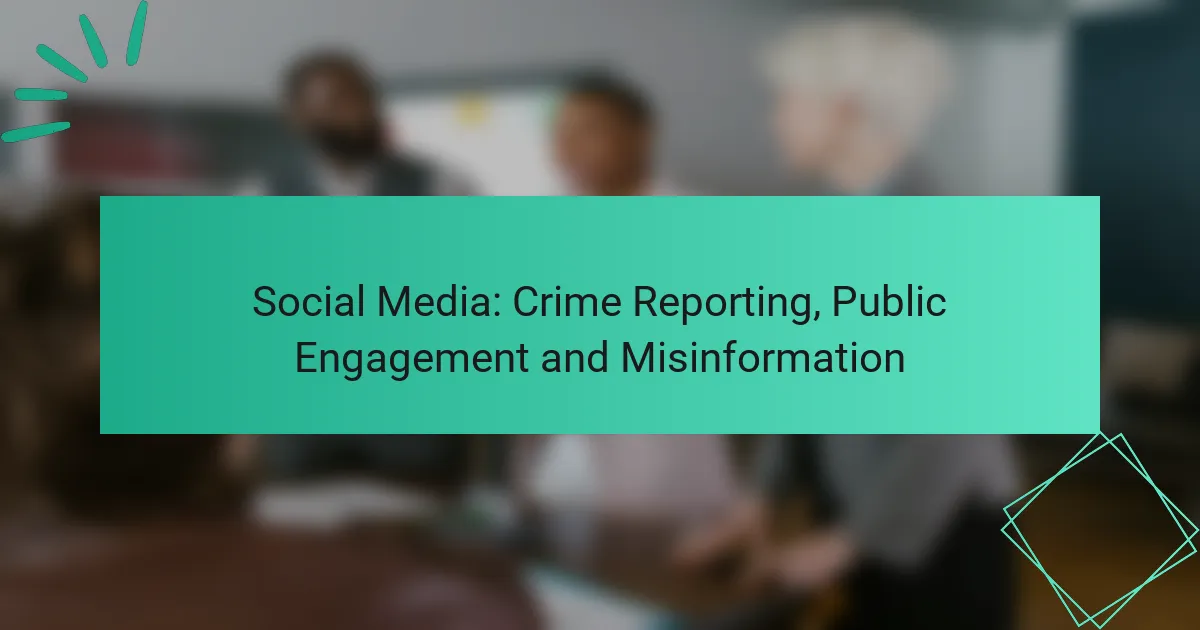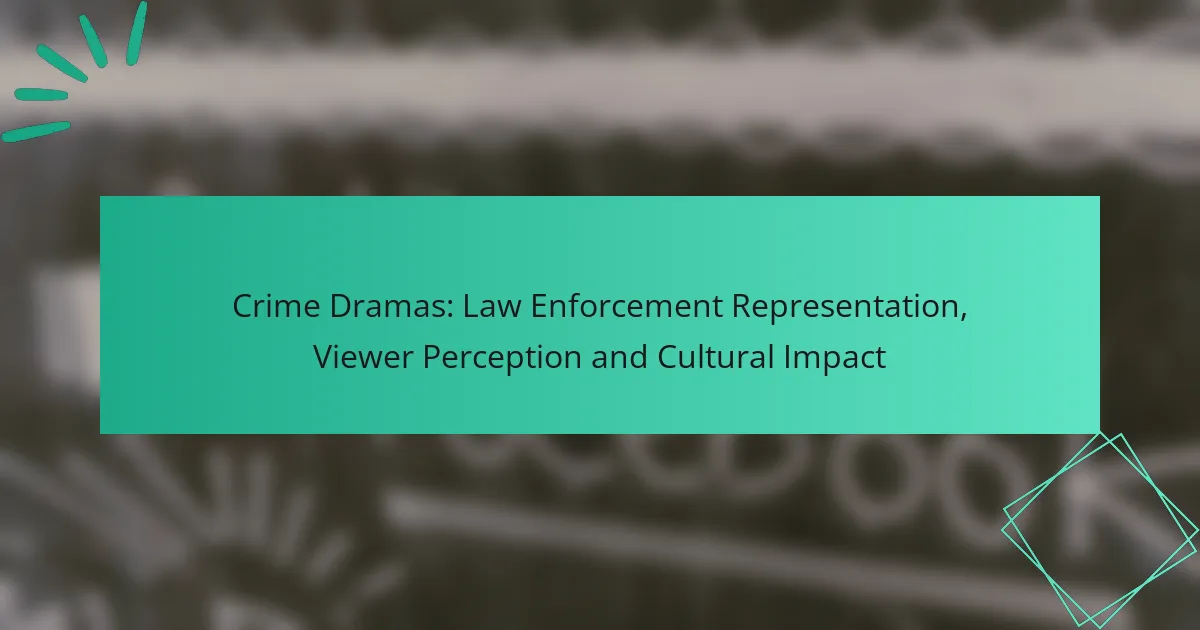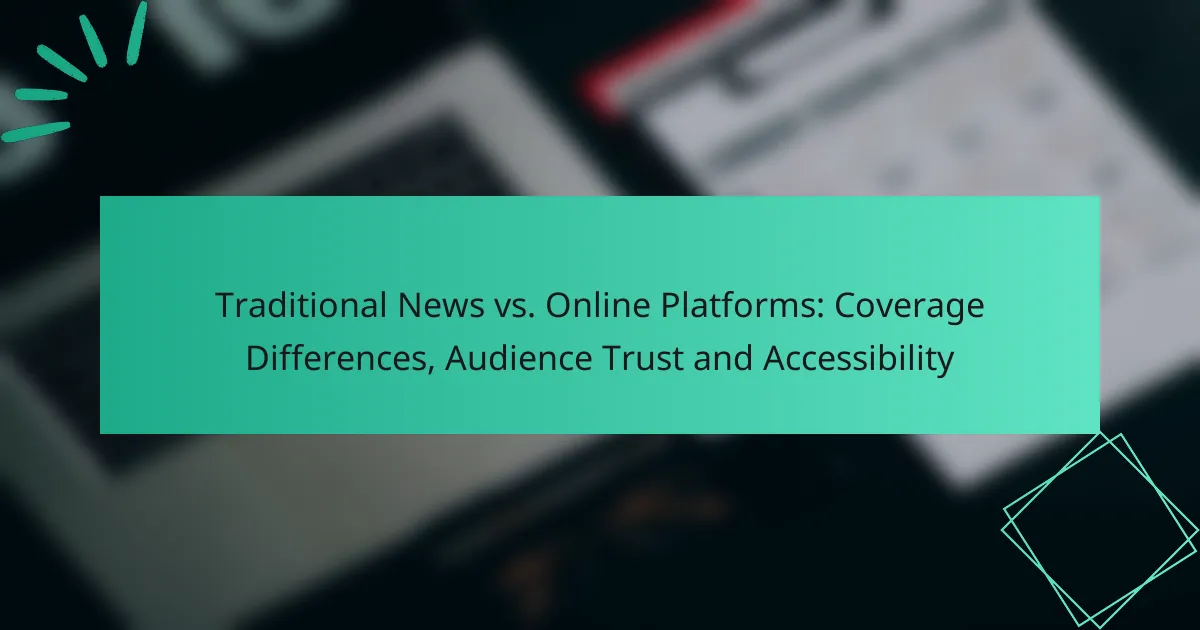Social media plays a pivotal role in crime reporting by offering immediate access to information and fostering community engagement. Platforms like Twitter and Facebook enable citizens to share updates and collaborate with law enforcement, enhancing the effectiveness of crime reporting. However, the rapid spread of misinformation on these platforms poses challenges, as unverified content can easily reach large audiences, complicating public understanding and response to crime-related issues.
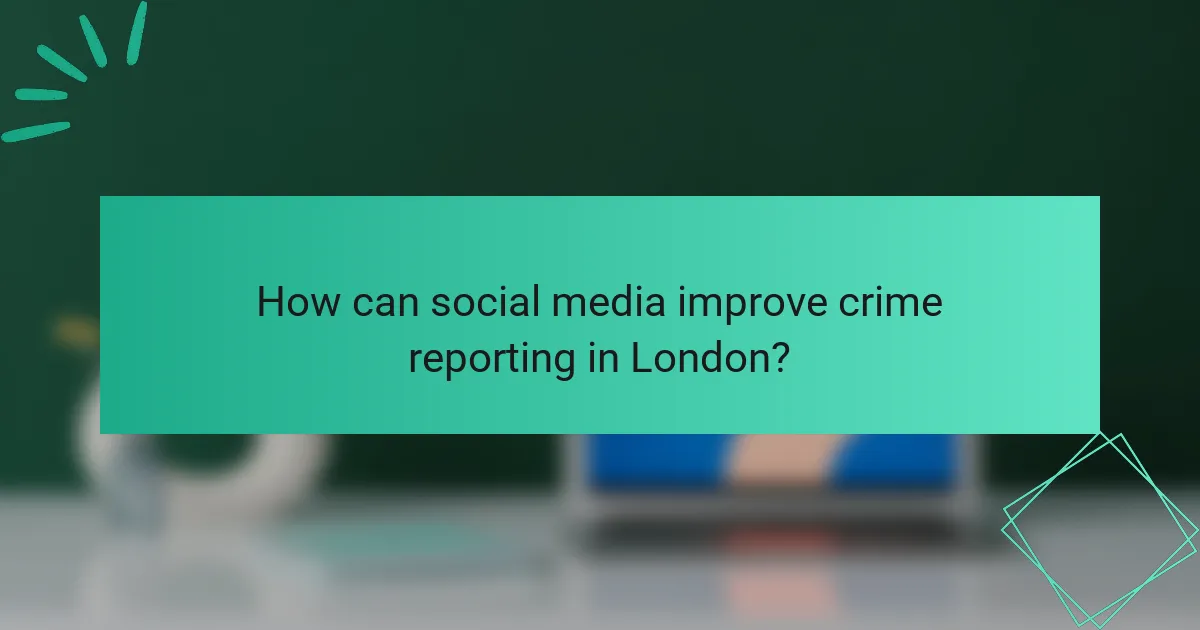
How can social media improve crime reporting in London?
Social media enhances crime reporting in London by providing immediate access to information and facilitating community involvement. Platforms like Twitter, Facebook, and Instagram allow citizens to share updates, engage with local law enforcement, and contribute visual evidence, making crime reporting more effective and timely.
Real-time updates via Twitter
Twitter serves as a powerful tool for real-time updates on crime incidents in London. Local police departments often use Twitter to disseminate urgent alerts, safety tips, and information about ongoing investigations, reaching a wide audience quickly.
Users can follow official accounts to receive notifications about nearby incidents, helping them stay informed. It is advisable to verify the source of information before sharing to prevent the spread of misinformation.
Community engagement through Facebook groups
Facebook groups foster community engagement by allowing residents to discuss local crime issues and share experiences. These groups can serve as a platform for residents to report suspicious activities or seek advice on safety measures.
Active participation in these groups can enhance neighborhood watch efforts and build stronger community ties. However, it is essential to maintain respectful dialogue and avoid spreading unverified claims that could lead to panic or misinformation.
Use of Instagram for visual evidence
Instagram is increasingly used for sharing visual evidence related to crime reporting in London. Users can post photos or videos of incidents, which can be crucial for investigations and raising awareness about local safety concerns.
When sharing content, users should ensure that it is relevant and does not infringe on privacy rights. Tagging local law enforcement or using relevant hashtags can help in getting the right attention to the posts, but users should always prioritize accuracy over speed in their reporting.

What are the best practices for public engagement on social media?
Effective public engagement on social media involves strategies that foster interaction and build trust within the community. Utilizing local influencers, creating interactive content, and hosting live sessions can significantly enhance communication and participation.
Utilizing local influencers for outreach
Local influencers can amplify your message and reach a wider audience by leveraging their established trust within the community. Collaborating with influencers who align with your organization’s values can lead to more authentic engagement and increased visibility.
When selecting influencers, consider their follower demographics and engagement rates to ensure they resonate with your target audience. A good practice is to establish clear expectations and provide them with the necessary information to accurately represent your cause.
Creating interactive polls on community issues
Interactive polls are an effective way to gauge public opinion on pressing community issues. They not only encourage participation but also provide valuable insights that can inform decision-making.
To maximize engagement, keep polls concise and relevant, and promote them across various platforms. Consider using tools like Twitter polls or Instagram Stories, which allow for quick responses and can generate discussions around the results.
Hosting live Q&A sessions on Facebook
Live Q&A sessions on Facebook provide an opportunity for direct interaction between community members and representatives. These sessions can address concerns, clarify misinformation, and foster a sense of transparency.
To ensure a successful session, promote it in advance and encourage participants to submit questions beforehand. During the live event, maintain a welcoming tone and be prepared to address both positive and negative feedback constructively.
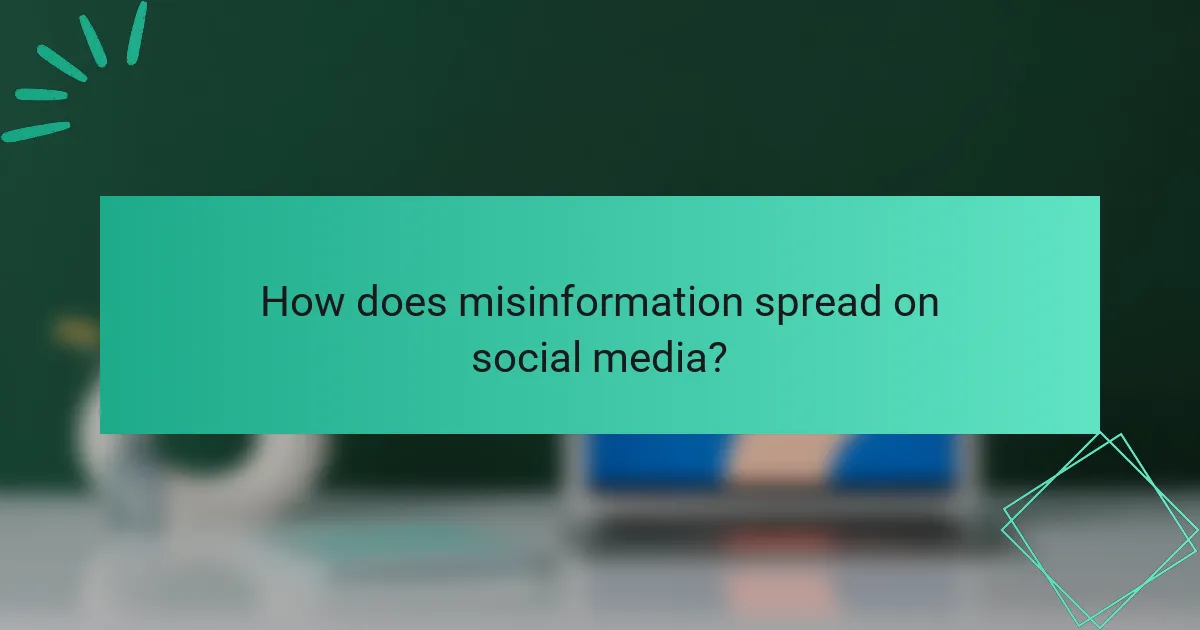
How does misinformation spread on social media?
Misinformation spreads on social media primarily through the rapid sharing of unverified content, often amplified by algorithms that favor sensational news. This creates an environment where false information can reach large audiences quickly, complicating public understanding and response.
Viral sharing of unverified content
The viral nature of social media allows unverified content to be shared widely in a short period. Users often share posts without checking the facts, driven by emotional reactions or sensational headlines. This can lead to a cascade effect, where misinformation spreads rapidly across networks.
For example, a misleading post about a crime can gain thousands of shares within hours, influencing public perception and potentially inciting fear or panic. Users should be cautious and verify information before sharing to mitigate this issue.
Algorithmic amplification of sensational news
Social media platforms use algorithms that prioritize engagement, often promoting sensational or controversial content over factual reporting. This means that posts that evoke strong emotions, whether true or false, are more likely to appear in users’ feeds.
As a result, misinformation can dominate discussions, overshadowing accurate information. Users should be aware of this bias and seek out reliable sources to ensure they are informed by accurate news rather than sensationalized stories.
Lack of media literacy among users
A significant factor in the spread of misinformation is the general lack of media literacy among social media users. Many individuals are not equipped to critically evaluate the sources or content they encounter online, leading to the acceptance of false information as truth.
Improving media literacy can help users discern credible information from misinformation. Educational initiatives that teach critical thinking and fact-checking skills are essential in empowering users to navigate social media more effectively.

What tools can combat misinformation in the UK?
In the UK, various tools are available to combat misinformation, enhancing public awareness and encouraging responsible sharing. These tools include fact-checking platforms, browser extensions for source verification, and social media reporting features that help users identify and report false information.
Fact-checking platforms like Full Fact
Fact-checking platforms such as Full Fact play a crucial role in verifying claims made in the media and on social media. They provide evidence-based assessments of statements, allowing users to understand the accuracy of information before sharing it. Full Fact is independent and funded by donations, ensuring impartiality in its evaluations.
Users can easily access reports on various topics, from politics to health, making it a valuable resource for anyone looking to confirm the validity of information. Engaging with these platforms can help foster a more informed public discourse.
Browser extensions for verifying sources
Browser extensions like NewsGuard and Media Bias/Fact Check help users assess the credibility of news sources while browsing. These tools provide ratings and background information on websites, indicating their reliability and potential biases. By using these extensions, individuals can make more informed decisions about the content they consume and share.
When installing a browser extension, ensure it is from a reputable source and regularly updated to maintain its effectiveness. This proactive approach can significantly reduce the spread of misinformation online.
Social media reporting features
Most social media platforms, including Facebook and Twitter, offer built-in reporting features that allow users to flag potentially false information. By using these tools, users can alert platform moderators to misleading content, which can then be reviewed and addressed accordingly. This collective effort helps maintain the integrity of information shared on these platforms.
To effectively use these features, familiarize yourself with the reporting guidelines of each platform. Reporting misinformation not only helps others but also contributes to a healthier online environment. Remember to provide context when reporting, as this can aid in the review process.
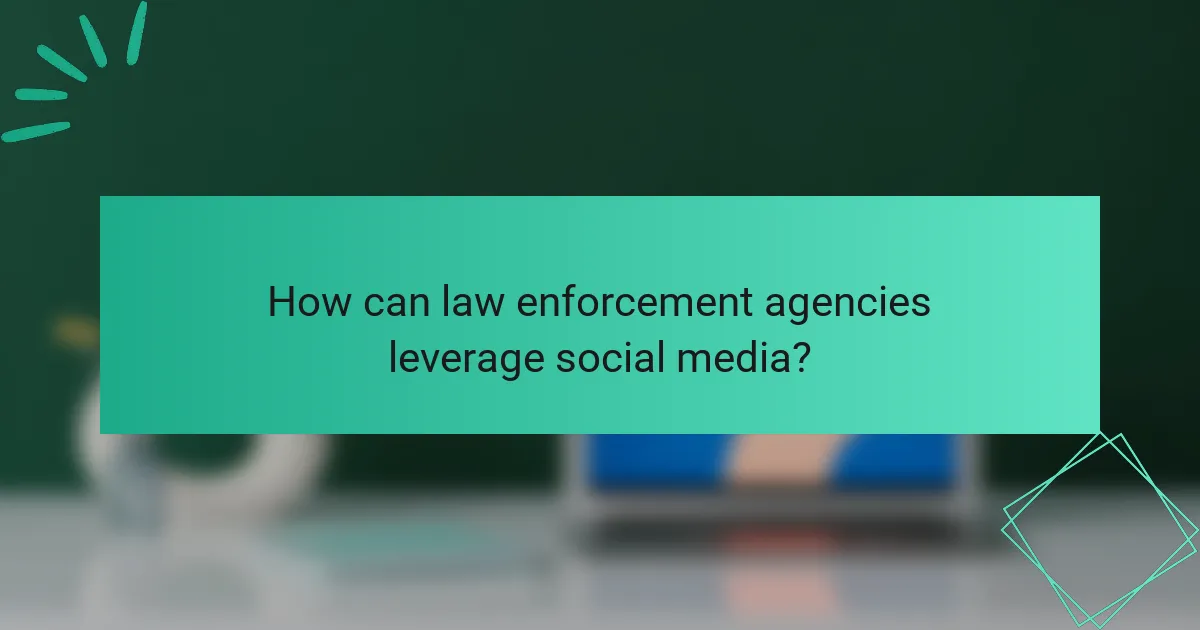
How can law enforcement agencies leverage social media?
Law enforcement agencies can effectively leverage social media to enhance communication, build community trust, and gather valuable insights on crime trends. By utilizing various platforms, they can engage with the public, disseminate information quickly, and foster a collaborative environment for crime reporting and prevention.
Building trust through transparency
Transparency is crucial for law enforcement agencies aiming to build trust within their communities. By openly sharing information about ongoing investigations, community initiatives, and departmental activities, agencies can foster a sense of accountability. Regular updates and clear communication can help demystify police work and encourage public support.
For instance, agencies can post about the outcomes of community-policing efforts or share statistics on crime reduction. This openness can lead to increased public confidence and cooperation, essential for effective policing.
Engaging with the community on platforms
Engagement on social media platforms allows law enforcement to connect directly with community members. Agencies can utilize platforms like Facebook, Twitter, and Instagram to share safety tips, announce community events, and solicit feedback on local issues. This two-way communication can enhance public relations and create a more informed citizenry.
Additionally, hosting live Q&A sessions or community forums online can provide a space for residents to voice concerns and ask questions. Such interactions can strengthen relationships and encourage community involvement in crime prevention efforts.
Using analytics for crime trend analysis
Analytics tools available on social media platforms can help law enforcement agencies identify and analyze crime trends. By monitoring discussions, hashtags, and location-based data, agencies can gain insights into emerging issues and public sentiment. This information can guide resource allocation and strategic planning.
For example, if a spike in discussions about a specific crime type is detected, agencies can respond proactively by increasing patrols in that area or launching targeted awareness campaigns. Utilizing analytics effectively can lead to more informed decision-making and improved community safety.

What are the legal considerations for crime reporting on social media?
When reporting crimes on social media, it is crucial to consider legal implications such as defamation, privacy rights, and data protection laws. These factors can significantly impact how information is shared and what content can be legally published.
Data protection regulations under GDPR
The General Data Protection Regulation (GDPR) governs how personal data is handled within the European Union. When reporting crimes, individuals’ personal information must be protected, ensuring that any shared data does not violate their privacy rights.
Under GDPR, consent is a key principle. If a crime report includes identifiable information about individuals, explicit consent is often required before sharing that information. Failing to obtain consent can lead to significant fines and legal repercussions.
Additionally, organizations should implement data minimization practices, only sharing information that is necessary for the report. This approach not only complies with GDPR but also helps maintain public trust and safety.
